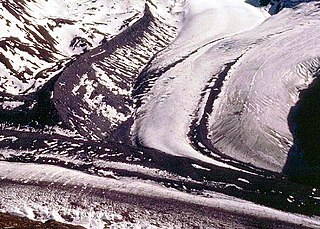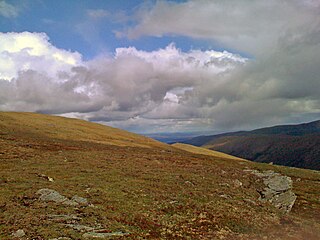Related Research Articles

A glacier is a persistent body of dense ice that is constantly moving under its own weight. A glacier forms where the accumulation of snow exceeds its ablation over many years, often centuries. It acquires distinguishing features, such as crevasses and seracs, as it slowly flows and deforms under stresses induced by its weight. As it moves, it abrades rock and debris from its substrate to create landforms such as cirques, moraines, or fjords. Although a glacier may flow into a body of water, it forms only on land and is distinct from the much thinner sea ice and lake ice that form on the surface of bodies of water.

Snow comprises individual ice crystals that grow while suspended in the atmosphere—usually within clouds—and then fall, accumulating on the ground where they undergo further changes. It consists of frozen crystalline water throughout its life cycle, starting when, under suitable conditions, the ice crystals form in the atmosphere, increase to millimeter size, precipitate and accumulate on surfaces, then metamorphose in place, and ultimately melt, slide or sublimate away.

Fairbanks is a home rule city and the borough seat of the Fairbanks North Star Borough in the U.S. state of Alaska.

Glaciology is the scientific study of glaciers, or more generally ice and natural phenomena that involve ice.

An icicle is a spike of ice formed when water falling from an object freezes.

Black ice, sometimes called clear ice, is a thin coating of glaze ice on a surface, especially on streets. The ice itself is not black, but visually transparent, allowing the often black road below to be seen through it. The typically low levels of noticeable ice pellets, snow, or sleet surrounding black ice means that areas of the ice are often practically invisible to drivers or people stepping on it. There is, thus, a risk of slippage and subsequent accident due to the unexpected loss of traction.

The East Greenland Current (EGC) is a cold, low-salinity current that extends from Fram Strait (~80N) to Cape Farewell (~60N). The current is located off the eastern coast of Greenland along the Greenland continental margin. The current cuts through the Nordic Seas and through the Denmark Strait. The current is of major importance because it directly connects the Arctic to the Northern Atlantic, it is a major contributor to sea ice export out of the Arctic, and it is a major freshwater sink for the Arctic.

The Yukon Quest, formally the Yukon Quest 1,000-mile International Sled Dog Race is a sled dog race scheduled every February since 1984 between Fairbanks, Alaska, and Whitehorse, Yukon. Because of the harsh winter conditions, difficult trail, and the limited support that competitors are allowed, it is considered the "most difficult sled dog race in the world", or even the "toughest race in the world"—"even tougher, more selective and less attention-seeking than the Iditarod Trail Sled Dog Race." The originator envisioned it as "a race so rugged that only purists would participate."

Lake Puma Yumco is a lake located at 5,030 m (16,500 ft) above mean sea level on the southern Tibetan Plateau, and is situated within Nagarzê County of the Tibet Autonomous Region. It is 32 km (20 mi) long, 14 km (8.7 mi) wide, and covers an area of 280 km2 (110 sq mi). Streams of water from the snow-capped surrounding mountains feed the lake, and its water surplus flows into Yamdrok Lake via an outlet located at its southeastern end. Some sediment can be seen entering the lake at its western end.

An ice road or ice bridge is a human-made structure that runs on a frozen water surface. Ice roads are typically part of a winter road, but they can also be simple stand-alone structures, connecting two shorelines. Ice roads may be planned, built and maintained so as to remain safe and effective, and a number of guidelines have been published with information in these regards. An ice road may be constructed year after year, for instance to service community needs during the winter. It could also be for a single year or two, so as to supply particular operations, such as a hydroelectric project or offshore drill sites.

Jujiro Wada was a Japanese adventurer and entrepreneur who achieved fame for his exploits in turn-of-the-20th-century Alaska and Yukon Territory.

A lead is a large fracture within an expanse of sea ice, defining a linear area of open water that can be used for navigation purposes. Leads vary in width from meters to hundreds of meters. As is the case for polynyas, leads allow the direct interaction between the atmosphere and the ocean, and are important for Arctic sea ice ecology. Additionally it has been lately found that ice leads contribute significantly to the amount of mercury deposited onto surface and leaked into the ocean. If the air is cold enough, the water within a lead quickly refreezes, such that in many cases, leads are partly or entirely covered by a thin layer of new ice.

Sebastian Schnuelle is a Canadian dog musher and dog sled racer from Whitehorse, Yukon, who won the 2009 1,000 mile Yukon Quest sled dog race. Schnuelle is fluent in English, French, and German. Nicknames: 'Sab' or 'the Armchair Musher'.
Charlie Biederman was a musher in Alaska best known for being the last surviving dog sled mail carrier in the United States. Charlie was born in Alaska as the son of Ed Biederman, a musher born in Bohemia who immigrated to the United States in 1874 and also delivered the mail via dog sled. The date of Charlie's birth is unclear, but contemporary U.S. Censuses indicate it likely was around 1919. Charlie had four siblings. Charlie was raised in Eagle, Alaska, but lived in an isolated cabin on the Yukon River for most of his life. From an early age, he assisted his father and brother in their winter deliveries of the mail to isolated cabins in central Alaska. In winter, the family lived in Eagle and ran the mail route between that town and Circle, another small settlement approximately 158 miles (254 km) downriver. In the summer, the family lived at their Yukon River cabin, harvesting fish for subsistence and boarding the dogs of fellow mushers. In 1938, the family were underbid for the main contract for mail delivery in the area by a bush pilot. Ed Biederman retired shortly afterward and died in 1945. The final dog sled mail route was replaced in 1963. That final route was from Gambell to Savoonga and was run by Chester Noongwook. In January 1995, he donated the mail-delivery sled he used to the National Postal Museum in Washington, D.C., where it hangs today. One month after making the delivery, he died on February 22, 1995.

Eagle Summit is a 3,652 feet (1,113 m)-tall gap through the White Mountains of central Alaska. The gap was named after the nearby Eagle River by prospectors from nearby Circle, Alaska.
Rosebud Summit is a 3,640 feet (1,109 m) peak that constitutes the northeasternmost point in the Rosebud Ridge of the White Mountains in central Alaska. The mountain is traversed by the trail of the annual Yukon Quest 1,000-mile sled dog race. It lends its name to nearby Rosebud Creek.

The 2009 Alaska floods were a series of natural disasters taking place in the United States state of Alaska during April and May 2009. The floods were a result of heavier-than-normal winter snowfall and above-average spring temperatures that resulted in rapid melting of the winter snowfall. The resulting high water levels were magnified in places by the development of ice dams which caused catastrophic flooding. The record-breaking flood that affected Eagle, Alaska in early May is the best example of an ice dam causing flooding beyond the norm.

The Jamaica Dogsled Team is a team of sled dogs and mushers headquartered at Chukka Caribbean Adventures in Ocho Rios, located in Saint Ann Parish, Jamaica. The dog team is made up of strays rescued by the Jamaica Society for the Prevention of Cruelty to Animals and offers dryland dogsled rides, along with the adventure center's other outdoor experiences. In addition, the two mushers Newton Marshall and Damion Robb, compete in sled races throughout the US and Canada, using leased dog teams. Country music singer Jimmy Buffett's Margaritaville is the team's major sponsor.

The history of Fairbanks, the second-largest city in Alaska, can be traced to the founding of a trading post by E.T. Barnette on the south bank of the Chena River on August 26, 1901. The area had seen human occupation since at least the last ice age, but a permanent settlement was not established at the site of Fairbanks until the start of the 20th century.
References
- Saari, Matias. "Jumble ice a jarring experience for some mushers, dog teams", Fairbanks Daily News-Miner. February 13, 2008. Accessed February 25, 2009.
- Saari, Matias. "Yukon River a jumble of problems for Quest mushers", Fairbanks Daily News-Miner. January 29, 2009. Accessed February 25, 2009.